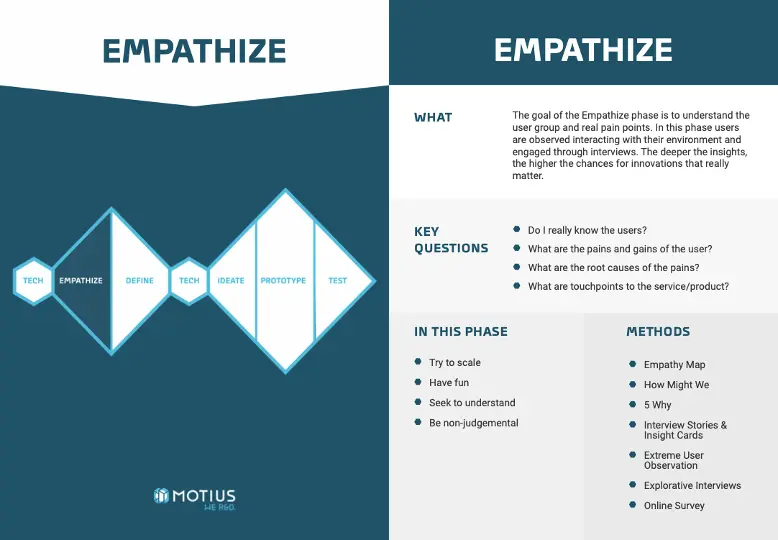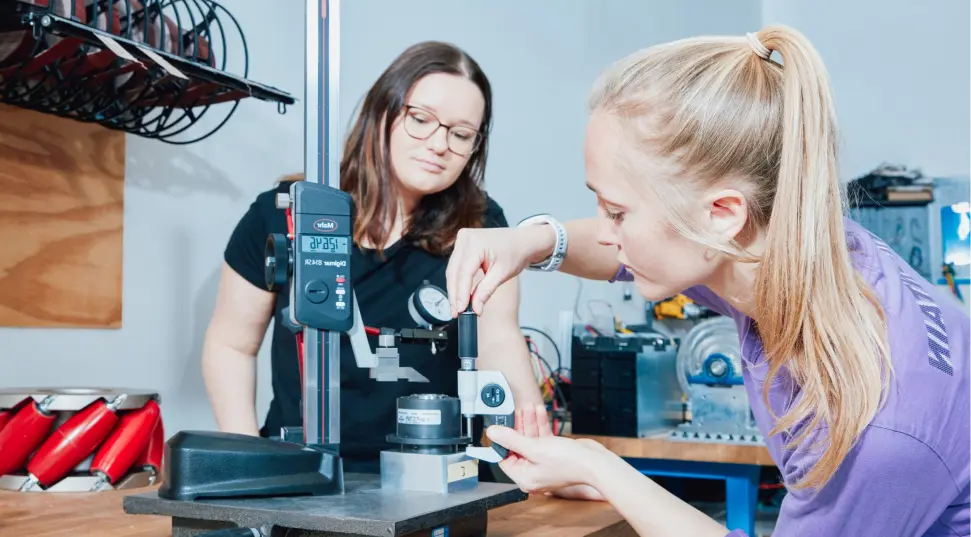In my last blog post, I explained that combining user-centric Design Thinking with emerging technologies is crucial if you want to optimize your technology innovation process. Now it is time to get away from high-level explanations and dive into more detail.
Following the Standard Process Will Lead To Failure
As the number of Design Thinking processes that are out there is high, there are some variations in the actual steps and what they are called. So, when referring to a standard process, it makes sense to take the most famous process. Probably, that is the Design Thinking process from Stanford’s D.School which consists of five different phases:

- Empathize: understand the user group and real pain points.
- Define: scope a meaningful challenge and define the user‘s view of the problem.
- Ideate: come up with solutions for the previously defined Point of View Statement.
- Prototype: design a maximum realistic prototype with only limited resources to test the key features of your solution.
- Test: engage in continuous, short-cycle innovation processes and product improvements triggered by tests.
Without a doubt, going through this standard Design Thinking process significantly enhances innovation processes and outcomes. In fact, 69% of organizations say that Design Thinking enhances their innovation processes.
But the likelihood of its success heavily depends on the application of the process. It is not a step by step process like a recipe in a cooking book — it is about understanding the user-centric mindset and putting the user into the center of innovative products and services.
We Need a Better Design Thinking Process for Tech Innovations
A quick fact check to set the context: The latest Gartner Hype Cycle alone counts more than 15 emerging technologies as “innovation triggers”. Of course, there are countless others, but this already makes our point clear: emerging technologies are more relevant for innovation than ever before.

At the same time, numerous studies keep indicating that Design Thinking significantly improves innovation processes. Want some numbers? Here you go:
- 71% of organizations say that Design Thinking improves their working culture
- About 30% of organizations say that Design Thinking increases their sales
- About 20% of organizations say that Design Thinking reduces their cost
That sounds promising, right?
Well, here is the catch: big corporations often do not get a hold of these benefits because they lack technical expertise, do not have the right tools, do not dare to take risks, or have a wrong failure culture when it comes to innovation. That is why smaller, agile innovation partners like Motius can be an ideal partner, especially in radical innovations with emerging technologies (as I explained in this article).
But even for us, Design Thinking came with some obstacles, as the standard approach was simply not sufficient. We were aiming for a process that gives us more opportunities to leverage the know-how of our talent pool and our broad expertise with emerging technologies.
The Motius Design Thinking Process
Looking at Motius’ Design Thinking process below, you can see that we added two hexagons to the standard double-diamond. These two extra phases are heavily focused on technology. Why? Within these tech hexagons, we do what we call technology education.

In our first tech hexagon, we introduce our customers to different technologies in order to make them more familiar with all the possibilities and trends that are out there. As every project has specific requirements and sometimes customers already have concrete ideas in mind, we ultimately need to assess which technology is best for a project. For that, the first tech education helps to phrase the right questions for the empathize phase and allows the interviewer to already have a first ideation when talking to the customer.
After the empathize and define phases, we provide tech education again. This time, it is important to get an understanding of different relevant technologies. The main idea is to widen the solution space of the participants: knowing about the latest applications of AR or hearing about the capability of a blockchain solution helps participants to create a larger solution space in the ideation phase.
Result? We are ready to enter the second diamond — where we add even more tech to the process. Although we involve general technology experts from the very beginning, the second diamond heavily relies on specific expertise to constantly assess feasibility as well as develop and test prototypes quickly.
Ensuring User-Centricity Through Higher Flexibility
The whole Design Thinking process is embedded in a product development roadmap. This means that we will take the first prototype to an MVP and all the way to the product rollout.
That is also why our Design Thinking process needs to be flexible: there is no one-size-fits-all process for every project. In fact, there are different formats and starting points, depending on the customer’s needs. That is why we built the whole process and its individual steps in a modular way.
Based on the feedback we got from customers, we have identified three different formats for different goals and outcomes:
- Design Thinking: solve complex problems in a highly user-centric way (process as you can see above)
- Tech Track: apply a certain technology and understand its benefits and limitations for the customers’ use cases (start with the second hexagon)
- Idea Track: solve a problem when customers already have identified a specific challenge but want more insights and knowledge on how the final solution or product should look like (start with ideation)
Keep in mind that whatever the exact format of the project is, we make sure to always keep the main aspect of our Design Thinking process: user-centricity.
Introducing the Motius Design Thinking Method Set
In order to always stay user-centric, we have created our own Design Thinking method set with structured cards for different phases and methods.

The Phase Cards
Think of it like an introductory card game: Phase cards explain four key aspects of the respective process phase. They tell you what the phase is about, what you are doing in the phase, which key questions will be answered and what methods are suitable in that phase.
With that, our phase cards help to recognize where in the process you are at any given moment, what you are trying to achieve and what you can do next to get there. Just have a look at our empathize phase card above.

The Method Cards
Each phase comes with various different method cards. Obviously, not every method is always applicable or suitable to every step along the way. So, our method cards are always related to certain goals and processes within the bigger picture while they still allow room for individual requirements.
Cannot imagine what they look like? Check out one of our favourite methods for the ideation phase above — the Idea Tower.
The cards do not just explain the what, how and why, but also give you a special Motius tip for each method. Further, they show the required time, how many people are involved, how difficult it is and what kind of tools you need.
Together, our phase and method card address user’s needs by keeping them on track throughout the whole process. Neither will you get stuck, nor will you get lost — two things that happen way too often in innovation processes.
Tech Focus, Flexibility and User-Centricity
As I said in the beginning, the Motius Design Thinking process is a unique modular process built to create true innovations with emerging technologies. It is a process that differentiates us from any other agency and is tailored to the individual customers requirements.
What makes it so unique is that we combine all our technology expertise with different Design Thinking methods to create the best solution possible. We do not get stuck during our process, we do not run out of ideas, we do not lose our technology focus and user-centricity. We have created the process that you need to conquer any challenge.
Want to know how much is behind all these bold statements? Just send us a message and we will be happy to show you!










